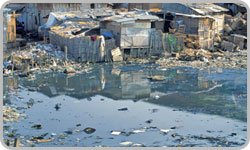Indonesia Environmental Issues
As the world’s largest archipelago of 17, 000 islands, Indonesia spans two bio-geographic regions - the Indomalayan and Australasian - and supports tremendous biodiversity of animal and plant life in its pristine rain forests and its rich coastal and marine areas. Up to 3, 305 known species of amphibians, birds, mammals, and reptiles and at least 29, 375 species of vascular plants are endemic to the islands, estimated at 40 per cent of APEC’s biodiversity. Indonesia’s stunning natural environment and rich resources however, are facing sustained challenges both from natural phenomena – it is located in the highly seismic Pacific Ring of Fire which experiences 90 percent of the world’s earthquakes and human activity.
The growing pressure of population demands together with inadequate environmental management is a challenge for Indonesia that hurts the poor and the economy. For example, total economic losses attributable to limited access to safe water and sanitation are conservatively estimated at 2 percent of GDP annually while the annual costs of air pollution to the Indonesia economy have been calculated at around $400 million per year. These costs are typically disproportionately borne by the poor because they are more likely to be exposed to pollution and less likely to be able to afford mitigation measures.
Natural resource challenges have persisted and become more complicated after decentralization. For example, the forest sector has long played a pivotal role in supporting economic development, the livelihoods of rural people and in providing environmental services. However, these resources have not been managed in a sustainable or equitable manner. Turning this situation around will require a new vision, led by the Government, of what a viable and environmentally sound forestry sector might look like.
The country’s administrative and regulatory framework cannot yet meet the demands of sustainable development in spite of a long history of support for policy and capacity development both from within the government and with international donor support. Indonesia’s ministries concerned with environment and natural resources management have benefited from good national level leadership, and also from an active network of civil society organizations throughout the country that are focused on environmental issues, with significant advocacy experience. Yet, improving Indonesia’s approach to environment and natural resources management is difficult.
Two reasons account for much of the poor performance: First, despite the substantial investment in environment and natural resources policy and staff development, actual implementation of rules and procedures has been poor and slow due to weak commitment by sector agencies, low awareness in local departments and capacity challenges at all levels. Also, awareness about the expected negative environmental impacts of sustained economic growth and the mechanisms for stakeholders to hold government agencies accountable for their performance are weak. Second, there is little integration of environmental considerations at the planning and programmatic levels, especially in the public investment planning process and in regional plans for land and resource use.










